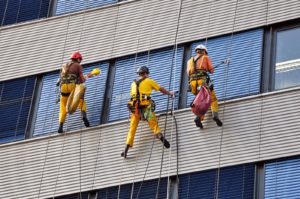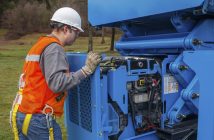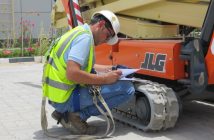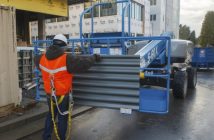It sometimes surprises people to have to think of ropes and ladders as tools, PBI Height Safety specialist Doug Carson observes
Everyone knows how to use a ladder, yet ladders and rooftop falls contribute to 70 per cent of all workplace injuries when working at height – most of which are less than three metres.

These figures suggest not all of us do know how to use a ladder in a safe manner. In fact, we are often unknowingly using ladders that are too short for the job and in positions that increase the likelihood of serious injury or death.
Preventing falls from height is often avoided by simply treating ladders and ropes as important pieces of Personal Protective Equipment (PPE) coupled with basic training, regular inspection and documentation.
Harnesses and ancillary gadgetry used for fall protection also require the same level of inspection and documentation.
Everyone has a responsibility to take reasonable practicable steps to ensure conformance, competence and compliance.
Ladder logic
Ladders are principally a means of access which are not designed as work platforms. However, they offer quick options for short duration work, difficult access and jobs where space is limited.
In construction and engineering, many jobs require the use of a ladder if only to support the need for close-up inspections. Where common or repetitive tasks require ladder access then real consideration should be given to more permanent solutions like stairs and walkways.
While there is a requirement that all ladders used within a workplace ‘shall comply’ (mandatory requirement) with the New Zealand standard AS/NZS 1892, there is also a requirement for them to be ‘fit for purpose’.
Given the large range of shapes and sizes of ladders available, thought should be given to choosing the right one for the job. There may be a need for more than one type of ladder.
Modern workplaces provide health and safety processes to ensure the fitness of tools for the job. This process requires analysing the work prior to starting and to determine the overall scope of works, along with the hazards and the risks and mitigations possible.
Being self-employed or part of a small business does not make you exempt from taking these steps.
The Health and Safety at Work Act 2015 clearly says that we all have a role to play in keeping each other safe and the ‘Best practice guidelines for working at height in New Zealand’ is the most relevant tool to help us achieve this.
By using these guidelines, we can ascertain whether ladders represent the safest method of access in the first place (including to perform work functions) or if other methods have better outcomes such as an Elevated Work Platform (EWP) or a scaffold.
Pre-planning pays
Considerations, such as the correct length, to ensure that ladders reach past the roof edge or platform by at least one metre means that the worker will not need to stand on the top steps of the stepladder or work at the top of it opened out. Pre-planning will show how the ladder can be secured or footed or otherwise stabilised.
Accidents regularly happen through an accumulation of events and faulty equipment is often a contributing factor. Regular (documented) inspections of the ladder with regard to bending cracking or other damage, which can only be seen when examined closely, will help minimise the risk. You should register or log each item.
New Zealand Standards state ‘the manufacturer’s guidelines shall (mandatory requirement) be followed and the safe handling and transportation requirements with regard to manual handling and staff injury’.
If our tools are fit for purpose, does that mean you are competent to use them? Competency is defined in the New Zealand standards as having a mix of knowledge, training and experience and like any tool, staff are required to be trained in the safe use of ladders and supervised until competent.
There are no specific unit standards for training on the use of ladders (given the range of possible uses), but often their use is incorporated into other safe work at height courses.
Specific training courses can always be arranged with a training provider or use an internal training programme that is organised to meet the needs of workers.
Staff need instruction on all the requirements, including safe work practice, selection and inspection, as well as safe lifting, handling and usage procedures.
The Best practice guidelines for working at height in New Zealand provide easy-to-use guidance for working with ladders and safety plans to minimise or eliminate risks.
To most of us, there are some obvious dos and don’ts such as overloading or over reaching, but there are other factors you may never have considered. For example, for the best anchorage while climbing a ladder always maintain three points of contact and consider a safety line in the event of a slip.
Roping risk
Like ladders, ropes are also tools. The use of ropes for work is as old as time itself but it is important to take a modern approach.
If you have made the decision to use rope on the job, then you are most likely in a position of high risk – knowing how to manage that risk is crucial. Relying on a line to help prevent serious injury (or death) requires a comprehensive understanding of how we use it to minimise or eliminate risks.
A rope with a job is often called a line – such as a handline, a haul line or a safety line. They are flexible by design and can be used for a range of tasks from fall protection systems, including creating restraint-like situations through to work positioning with the worker handsfree, or as fall arrest systems such as for those on ladders. They can be used for hauling of equipment and attaching as tag lines.
Ropes for PPE purposes, such as part of a fall arrest kit or a work positioning system, should always be kept separate from other types of ropes and slings.
If you put your trust in a length of rope to prevent a fall, do you really want to use a line that you’re unsure of its condition? Ropes used for life support purposes should meet AS/NZS 1891 – Static Lifelines or other international standards such as EN 1496.
Like any tool they need to be regularly inspected to ensure they are compatible with the items they are combined with. Organise a log and inspection regime and check rescue kits are pre-assembled ready for use.
Rope requirements
Using various gadgets for positioning on lines often requires specific types of rope and sizes to function adequately. Ensure you buy the right rope for job.
Commonly in New Zealand, ropes of a Kernmantle construction of 11mm in diameter give very good handling and performance in a range of situations. They commonly have a breaking strain of around 3000 kg, and can have sewn eyes or be knotted to length.
Ropes should have a tag, which is often a sleeve shrinkwrapped on with the relevant details for the user. They need to know its age and serial number for inspection and most importantly its length.
Where multiple pieces of rope with a variety of uses are circulating in a business, it will be more important to maintain good logs to make sure that individual ropes are correctly identified for inspection and use.
All rope comes with the manufacturer’s guidelines to follow and require a level of competence to use. Ensure all staff are trained for using rope for both working at height and rescue. Identify any risks or the likelihood of a hazard and the degree of harm that might result from working at height.
Factor any other PPE that will support you including the use of a height safety helmet. The use of a height safety helmets can drastically reduce serious harm during falls where the helmet is retained on the head.
There are specific EN (European Norms) standards that relate specifically to work at height and carry multi-impact test requirements. AS/NZS 1801 helmet standard relates to persons working on the ground and are only designed to reduce injury in the case of dropped objects.
There are number of specific places to obtain the latest information. Worksafe NZ offers information and guidance on its website (www.worksafe.govt.nz), which covers good practice for both the use ladders and other tools.
There are also guides for working on roofs, Work at Height (in general) and a best practice guide to Industrial Rope Access in New Zealand, which is very comprehensive in the general requirements.




